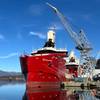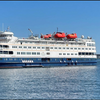For the first time in the history of the inland navigation system, a dam floated. The Braddock Dam Segment One floated into place and set down on Dec. 7, mating underwater with 47 drilled shafts that make up the dam segment's foundation. Vertical and horizontal alignment of the segment came within one inch of the design.
Segment One, the larger of two segments, is a reinforced concrete marine structure 330 ft. long and weighing 16,600 tons. On Dec. 5 towboats moved it from the project outfitting pier a mile-and-a-half upstream, then it was sunk in place. Underbase grouting filled the gap between the river bottom and underside of the dam segment. Concrete will be placed inside Segment One, then grouting will connect the tops of drilled shafts where they fasten to the underside of the segment.
Throughout construction, float-out, and setdown, thousands of people have watched on the Internet. The district installed webcams at the Leetsdale fabrication site and other sites overlooking Braddock Dam. Those interested can click on www.lrp.usace.army.mil. On the day of setdown, the number of visitors to the webcam page increased 20-fold.
Before the December setdown, and before outfitting and pier wall extensions, Braddock Dam Segment One was towed 27.5 miles along the Ohio and Monongahela rivers from its casting site at Leetsdale, Penn., to an outfitting dock at Duquesne, Penn.
The 15-hour trip last July 26 was a major media event in western Pennsylvania. The flotilla included the 3,300 horsepower primary towboat, two assist towboats, plus escort vessels from the Corps, Coast Guard, and Pennsylvania Fish and Boat Commission. Along the way, thousands of onlookers lined the riverbanks and cheered, as others tracked its progress on television and radio.
When completed, Braddock Dam Segment One will form the lower third of the pier bases and overflow sections for three bays of a five-bay gated navigation dam. Segment Two is waiting at the Leetsdale casting site for a similar voyage early this year.
Building the new Braddock Dam using "in-the-wet" methods is at the forefront of a Corps initiative to adapt cost-saving techniques to sustain the nation's navigation infrastructure. The Braddock project at Braddock, Penn., is part of the Lower Monongahela River Navigation Project. Replacing the nearly 100-year-old fixed crest dam with a gated dam will let Pittsburgh District replace old, inefficient locks at Charleroi, Penn., and eliminate the 100-year-old Locks and Dam 3 at Elizabeth, Penn.
Traditionally, inland navigation projects are built "in-the-dry" using large temporary cofferdams to provide a dry work area. When construction is complete, the cofferdam is flooded and removed. The "in-the-wet" technique eliminates the time and expense of a cofferdam, and allows building the dam segments off-site while the dam foundation system is built from a floating plant.
The Braddock Dam segments are being built in two hollow concrete segments, designed for floatation, that resemble large concrete barges. The segments are assembled at an off-site casting facility using both precast and conventional cast-in-place concrete. The dam segments comprise the overflow surfaces of the dam, the gate sills, part of the stilling basin, and a small portion of the pier bases. In all, 438 precast concrete panels, some weighing 80 tons, were cast and erected to form the exterior and internal diaphragm walls of the dam segments.
Dam Segment One, at 11,600-tons, measures 333 feet by 104 feet. (It's weight increased as more concrete and grout was added later.) Dam Segment Two, at 9,000-tons, measures 265 feet by 104 feet. The post-tensioned concrete base slab of each segment was cast around a grid of corrugated metal "cans" that align with 77 78-inch-diameter foundation drilled shafts in the foundation system. Reaction beams in the bottom slab transfer the segment dead weight to another 12 setdown shafts.
Flat jacks and steel pistons cast into the segment bottom slab allow leveling of the segment after setdown.
Foundation
The foundation is upstream and downstream sheet-pile cutoff walls, a graded gravel base, a grid of reinforced concrete drill shafts extending from the riverbed into bedrock, and a series of steel bearing piles for the dam tailrace area. Pre-excavation of the riverbed from the existing lock river wall to the left bank abutment toe provided a 140-ft. wide, 650-ft. long foundation footprint. The 400,000 cu. yds. of dredged material helped restore a nearby brownfield.
After pre-excavation, steel sheet piling was installed to provide both upstream and downstream cutoff walls that will restrict flow paths beneath the new dam, and act as retaining walls during other stages of work. The area between the completed cutoff walls was dredged to final grade, then covered with a graded gravel base. Then the drilled shafts and tailrace H-pile foundation were built.
The reinforced concrete drilled shafts will carry the weight of the dam and operating loads into bedrock. Each shaft is 78 inches in diameter and about 40 feet long, with 15 to 20 feet of the length drilled into bedrock. The dam tailrace will be supported by 150 steel bearing H-piles driven to bedrock.
Piecing it together
Before each segment can be positioned and submerged onto the foundation, each must be outfitted with additional bulkheads, work platforms, ballast piping and equipment, and the pier bases must extend to a height that will be above water after set down. After outfitting, each segment will be transported down river by towboats and positioned close to the set-down site.
Then, steel cables from winches attached to the segment will be run to six mooring piles, and the winch-cable system will position the segment above the set-down drilled shafts. The cables and mooring piles will hold the segment's alignment as water is pumped into the hollow compartments to slowly lower it onto the drilled shaft foundation.
Following set-down, the area between the graded gravel base and the bottom slab of each segment is grouted to prevent any water flow below the dam. After underbase grouting, the interior compartments will be filled with a combination of concretes. They will first be filled with a highly flowable concrete designed for underwater placement. Once this "tremie" concrete is placed, each compartment can then be dewatered and filled with concrete placed in the dry. Additional grout will "lock" the dam segment onto each foundation shaft.
Tailrace
After segment infilling, the dam tailrace will be built in-the-wet using interlocking pre-cast concrete panels. There are 31 tailrace panels, each more than 30 feet long and between 10 to 20 feet in width. Each panel will interlock with the adjoining tailrace panel and a special groove cast into the downstream edge of the dam segments.
The panels will be installed from cranes mounted on floating plant using a guide frame. The area beneath each tailrace panel will then be filled with tremie concrete to create a tailrace section supported by the H-pile system.
Completion
The upper 40 ft. of the five dam piers, the dam tainter gates and operating machinery, footbridges, and equipment buildings will be completed by floating plant. The dam's four tainter gates are 110 feet wide and each will be operated by large hydraulic cylinders.
Other features of the Braddock Dam project include a left closure weir that will connect the left end of the new concrete dam to the existing left abutment wall. A right closure also will be completed between the new dam and the existing lock wall. To complete the project, the existing fixed-crest concrete dam about 600 feet downstream will be removed down to the riverbed. The demolished materials will be placed in downstream locations for fish habitat. The work will be completed in 2003.
(Henry Edwardo, Brian Greene, and William Karaffa, all of Pittsburgh District, contributed to this article. The preceding was reprinted with permission from the US Army Corps of Engineers' Engineer Update, February 2002, Vol. 26. No. 2)
Sponsored Content
MSC Sets a New Standard for Time Off in 2025, Plus Earn a $38,340 Bonus as an Able Seaman!

Navigate Compliance with Confidence: Discover Carbon Diligence from ABS Wavesight

Featured videos

Xenos Marine Takes Aim at the Gulf Salvage, Decommissioning Markets

AI to the Rescue: Zelim’s ZOE to be Installed on Cruise Ship
April 2025
 Read the Magazine
Read the Magazine

 Read the Magazine
Read the Magazine
This issue sponsored by:

OPINION: Hold the Bricks, Start the Discussion on the Future of Domestic Shipbuilding
Subscribe for
Maritime Reporter E-News
Maritime Reporter E-News is the maritime industry's largest circulation and most authoritative ENews Service, delivered to your Email five times per week









